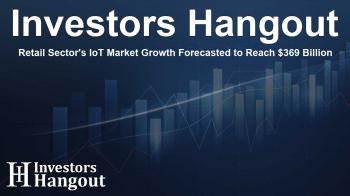Retail Sector's IoT Market Growth Forecasted to Reach $369 Billion

Significant Growth of IoT in the Retail Sector
The global market for IoT in retail is on a remarkable trajectory, with projections estimating growth from USD 61.54 billion in 2024 to an impressive USD 369.73 billion by 2032. This represents a robust CAGR of 25.22% over the period from 2025 to 2032. The increasing integration of connected devices in retail operations is revolutionizing inventory management, enhancing real-time analytics, and providing bespoke consumer experiences.
Driving Forces Behind IoT Expansion in Retail
The retail industry is evolving as it adopts IoT technology, paving the way for improved operational efficiencies. The rise in demand for RFID technology, automated checkout systems, and smart shelving solutions has become pivotal in this transformation. Retailers increasingly rely on IoT solutions to streamline their processes and enhance customer interactions.
U.S. Market Insights
In the United States alone, the IoT in retail market was valued at USD 15.15 billion in 2024. Forecasts suggest that this figure will soar to USD 89.37 billion by 2032, growing at a CAGR of 24.83% between 2025 and 2032. This surge is driven by an uptick in smart devices for inventory tracking, automated transactions, and sophisticated analytics, as well as the growing trends in e-commerce and digital payments that enhance operational efficacy and customer engagement.
Key Players Supporting the Market Growth
Several key players are influencing the landscape of the IoT in retail market. Major corporations like Cisco Systems, Inc., IBM Corporation, Microsoft Corporation, Honeywell International Inc., and Oracle Corporation are at the forefront, driving advancements in IoT technology and systems. Their innovations support retailers in integrating IoT solutions, making them essential partners in this transformation.
Market Segmentation Overview
The IoT in Retail market can be segmented based on deployment, application, connectivity, and components. Recent analyses suggest that:
Deployment Trends
The cloud segment was a leader in 2024, claiming a significant market share of 42%. Its cost efficiency and scalability make it a preferred choice for many retailers. Conversely, the on-premises segment is believed to grow at the fastest CAGR of 26.56% as businesses seek better data security and control over their systems.
Application Segments
Operations management emerged as the dominant application in 2024, representing around 33% of the market. Retailers continue to prioritize process automation and optimize resources extensively. Additionally, customer management is anticipated to rise with a CAGR of 27.58%, fueled by the desire for personalized shopping experiences and targeted marketing efforts.
Connectivity and Component Insights
The connectivity segment is also evolving, with Near Field Communication (NFC) dominating in 2024 with approximately 35% of the market share. Meanwhile, Bluetooth Low Energy is expected to expand rapidly as retailers implement it for in-store navigation and promotions. Furthermore, the hardware segment led the market with a substantial 47% in 2024, primarily due to the critical role of sensors and IoT devices.
Regional Market Insights
North America continues to dominate the IoT in retail market, with approximately 34% market share attributed to a strong technological foundation and the presence of major retail chains. Asia Pacific, however, is projected to experience rapid growth at a CAGR of 27.41%, driven by urbanization and increased smartphone penetration.
Recent Innovations and Developments
Recent developments highlight the industry's commitment to innovation. In 2025, Cisco introduced the “Collaboratory” in Manhattan, integrating IoT with advanced technologies to enrich shopping experiences. Additionally, in 2024, significant updates to the AI Store Assistant improved in-store support by enhancing personalization through integrated analytics.
Conclusion
The future of IoT in the retail market is bright and brimming with opportunities. As technology continues to evolve, retailers who adopt these innovations will undoubtedly enhance their operational efficiencies and customer interactions, reshaping the retail experience for years to come.
Frequently Asked Questions
What is the expected growth of IoT in the retail market?
The IoT in retail market is projected to grow from USD 61.54 billion in 2024 to USD 369.73 billion by 2032.
What are the key drivers for this market growth?
The growing use of connected devices, enhanced inventory management, and increasing demand for customized shopping experiences are major drivers.
Which applications are leading the IoT market in retail?
Operations management currently dominates, with significant growth anticipated in customer management applications.
What role do major corporations play in this sector?
Leading companies like Cisco, IBM, and Oracle are pivotal in developing and providing innovative IoT solutions for retailers.
What regions are expected to grow the fastest?
While North America leads in market share, the Asia Pacific region is set for rapid growth due to increasing urbanization and technology adoption.
About The Author
Contact Riley Hayes privately here. Or send an email with ATTN: Riley Hayes as the subject to contact@investorshangout.com.
About Investors Hangout
Investors Hangout is a leading online stock forum for financial discussion and learning, offering a wide range of free tools and resources. It draws in traders of all levels, who exchange market knowledge, investigate trading tactics, and keep an eye on industry developments in real time. Featuring financial articles, stock message boards, quotes, charts, company profiles, and live news updates. Through cooperative learning and a wealth of informational resources, it helps users from novices creating their first portfolios to experts honing their techniques. Join Investors Hangout today: https://investorshangout.com/
The content of this article is based on factual, publicly available information and does not represent legal, financial, or investment advice. Investors Hangout does not offer financial advice, and the author is not a licensed financial advisor. Consult a qualified advisor before making any financial or investment decisions based on this article. This article should not be considered advice to purchase, sell, or hold any securities or other investments. If any of the material provided here is inaccurate, please contact us for corrections.

